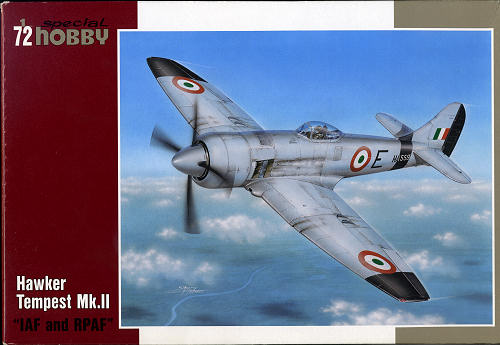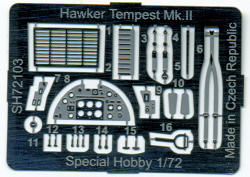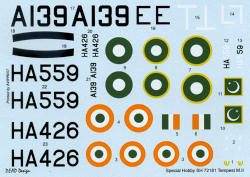
| KIT #: | 72181 |
| PRICE: | $25.90 at www.greatmodels.com |
| DECALS: | Three options |
| REVIEWER: | Scott Van Aken |
| NOTES: | Short run with resin and photo etch parts |

| HISTORY |
The decision to drop the Hawker Tornado allowed Sydney Camm and his design team to transfer the alternative engine proposals for the Tornado to the more advanced Typhoon II (later to be renamed "Tempest"). As a result the Tempest was designed from the outset to use the Bristol Centaurus 18 cylinder radial engine as an alternative to the liquid cooled engines which were also proposed. Two Centaurus powered Tempest Mk II prototypes were to be built.
The first Tempest Mark II, LA602, flew on 28 June 1943 powered by a Centaurus IV (2,520 hp/1,879 kW) driving a four-blade propeller. LA602 initially flew with a Typhoon-type fin and rudder unit. This was followed by the second, LA607, which first flew on 18 September 1943 and was assigned to engine development. Apart from the new engine and cowling, the Tempest II prototypes were similar to early series Tempest Vs. The main airframe difference was the addition of carburettor air intakes in the inner leading edges of both wings, with an oil cooler and air intake in the inner, starboard wing. LA607 was presented to the College of Aeronautics at Cranfield, Bedfordshire and is currently (2011) preserved at Fantasy of Flight at Polk city, Florida.
The radial engine installation owed much to examinations of a captured Focke-Wulf Fw 190, and was unprecedentedly clean and effective. One adopted feature was the use of individual exhaust stubs, laid out in a row down either side of the fuselage, rather than the front collector and large single exhaust used by the Centaurus powered Tornado. In spite of the promise of a more reliable powerplant than the Sabre, there were frustrating problems, including overheating, unreliable and leaking exhausts, insufficient crankshaft lubrication and propeller reduction gear seizures. There were also problems with vibration, but they were fixed by replacing the original "rigid" eight-point engine mounts with six-point rubber-packed shock mounts. In a further attempt to alleviate engine vibration, the four blade propeller was replaced with a five blade unit; eventually, a finely balanced four bladed unit was settled on.
Physically, the Tempest II was longer than the Tempest V (34 ft 5 in/10.5 m versus 33 ft 8 in/10.3 m) and 3 in (76 mm) lower. The weight of the heavier Centaurus engine (2,695 lb/1,222 kg versus 2,360 lb/1,070 kg) was offset by the absence of a heavy radiator unit, so that the Tempest II was only some 20 lb (9 kg) heavier overall. Performance was improved; maximum speed was 442 mph (711 km/h) at 15,200 ft (4,633 m) and climb rate to the same altitude took four and a half minutes compared with five minutes for the Tempest V. The service ceiling was increased to 37,500 ft (11,430 m)
The Centaurus was generally regarded as superior to the Sabre, particularly in terms of reliability, and the engine and Tempest airframe proved an excellent match. The combination looked so promising that a contract for 500 of the type was placed as far back as September 1942, but Gloster was overloaded with production of the Typhoon and development of the Gloster Meteor, and the company could not handle the additional load.
In 1943, the Tempest Mark II production contract was allocated to Bristol, and the switch delayed production even more. The first Tempest II was rolled off the line on 4 October 1944. With the end of the Second World War in sight, orders for the Tempest II were trimmed or cancelled; after 50 Tempest IIs had been built at Bristol's Banwell facility, production was stopped and shifted back to Hawker.
A total of 452 Tempest IIs were built, including 136 basic Mark IIs and 316 "Fighter Bomber Mark IIs" (FB II). They were built mostly by Hawker and generally with Centaurus V engines, and of that number, 300 were completed after the war. The Tempest II, despite its slightly improved performance and better reliability, never saw combat.
Tempest IIs produced during the war were intended for combat against Japan, and would have formed part of a proposed British Commonwealth long range bomber force based on Okinawa, Tiger Force. The Pacific War ended before they could be deployed.
The RAF passed 89 Tempest FB IIs to the Indian Air Force in 1947, while another 24 were passed on to the Pakistani Air Force.
| THE KIT |
 Back in the early days of modeling for your editor, the Matchbox Tempest II, complete with early IAF roundels, was a real favorite. Painted with a brush and eschewing such niceties as filled seams and proper colors, it sat on the shelves for years until destroyed in one of many moves.
Back in the early days of modeling for your editor, the Matchbox Tempest II, complete with early IAF roundels, was a real favorite. Painted with a brush and eschewing such niceties as filled seams and proper colors, it sat on the shelves for years until destroyed in one of many moves.
Now, we have a very nice replacement for that old Matchbox kit in the form of this one from Special Hobby. No idea if this is brand new or not as the gang at MPM don't seem to like to put dates on things, but since it comes in their latest box design and has vacuformed canopies, perhaps it has been released before.
 As usual, in addition to the two plastic sprues, we get a bag of resin and a photo etch fret. The resin takes care of the cockpit, wheel wells, forward cowling,wheels, exhaust, and wing edge intakes, while the photo etch covers a myriad of small items from the upper cowling screen, to seat harnesses, instrument panel and other nice bits and pieces. The kit does have an acetate sheet to take care of the instrument faces.
As usual, in addition to the two plastic sprues, we get a bag of resin and a photo etch fret. The resin takes care of the cockpit, wheel wells, forward cowling,wheels, exhaust, and wing edge intakes, while the photo etch covers a myriad of small items from the upper cowling screen, to seat harnesses, instrument panel and other nice bits and pieces. The kit does have an acetate sheet to take care of the instrument faces.
Injected plastic takes care of the rest. That includes upper and lower wings, fuselage halves, gear doors, wheels, tail planes, prop and spinner. I'm pleased that this does not have separate prop blades as often those are more of a pain than a ease in construction. The lone option for stuf f under wings are a pair of wing tanks. Thankfully, Special Hobby does not pre-drill holes for these so you can leave them off should you wish. A single one-piece canopy sits atop all this.
f under wings are a pair of wing tanks. Thankfully, Special Hobby does not pre-drill holes for these so you can leave them off should you wish. A single one-piece canopy sits atop all this.
Instructions provide very nicely done construction drawings that also include detail drawings and information using Gunze paints. Three markings options are provided. One is the box art plane in overall aluminum dope with black bits on wing tips, rudder and fuselage band as used by a training unit in 1951 with the Indian AF. The second IAF option is one in RAF shades of Dark Green, Ocean Grey and Medium Sea Grey from 7 squadron in 1946. The PAF option is with 14 Sqadron in Dark Earth, Midstone over Azure Blue. The sheet includes wing walk decals and what few stencils the plane carried.
| CONCLUSIONS |
So now we have a very nice and vastly superior Tempest II kit for the 1/72 crowd. Though not many were built or used by the PAF or IAF, they do make for an interesting subject and one that will add a lot to your shelf.
| REFERENCES |
June 2011 You can find this and many other very nice kits and accessories at www.greatmodels.com If you would like your product reviewed fairly and quickly, please contactme or see other details in the